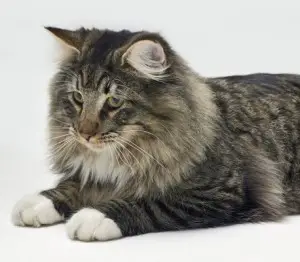Main diseases of the Norwegian Forest Cat include hip dysplasia and hypertrophic cardiomyopathy (HCM), a heart disease. Norwegian Forest Cats are susceptible to hip dysplasia, a condition that affects the hip joints and can cause pain and difficulty in movement.
Another common health concern for this breed is HCM, a heart disease that can lead to heart failure. It is important for Norwegian Forest Cat owners to be aware of these potential health issues and to take proactive measures to ensure the well-being of their feline companions.
Regular veterinary check-ups, a balanced diet, and an active lifestyle can help mitigate the risk of these diseases and provide a good quality of life for Norwegian Forest Cats.
Health Issues And Concerns
Norwegian Forest Cats may be prone to certain health issues. Upper respiratory infections are one common concern. Hypertrophic cardiomyopathy (HCM) is also a disease that affects this breed. Additionally, polycystic kidney disease (PKD) can be a serious issue for Norwegian Forest Cats.
Regular vet check-ups and a balanced diet are essential for maintaining their health. Providing a clean and stress-free environment can help prevent respiratory infections. Monitoring their heart health is vital to detect any signs of HCM early on. Regular screenings are necessary to identify PKD and provide appropriate treatment.
Keeping these health concerns in mind will ensure the well-being of your Norwegian Forest Cat.
:strip_icc()/norwegian-forest-cat-4170085-fe84aa86023446c4b64236ddfbdefd2b.jpg)
Credit: www.thesprucepets.com
Upper Respiratory Infections In Norwegian Forest Cats
Upper respiratory infections are common in Norwegian Forest cats. They exhibit symptoms such as sneezing, coughing, and nasal discharge. The infections can be caused by various pathogens, including viruses and bacteria. Prevention is key, and regular vaccinations can play a vital role in protecting your cat’s health.
Treatment may include antibiotic medication and supportive care to alleviate symptoms. Vaccinations can help in preventing upper respiratory infections, and it is crucial to follow the recommended vaccination schedule. Regular vet check-ups and maintaining good hygiene practices can also minimize the risk of infections.
As a responsible cat owner, staying informed about the potential diseases and taking preventive measures is essential to ensure the overall health and well-being of your Norwegian Forest cat.
Understanding Hypertrophic Cardiomyopathy (Hcm) In Norwegian Forest Cats
Norwegian Forest cats are susceptible to Hypertrophic Cardiomyopathy (HCM), a genetic condition. This disease is characterized by the thickening of the heart muscles, leading to various symptoms. Recognizing the signs of HCM is crucial for timely diagnosis and management. Common symptoms include difficulty breathing, lethargy, and irregular heartbeat.
A veterinarian can perform tests and scans to confirm the presence of HCM. Although there is no cure for this condition, it can be managed through medication and lifestyle adjustments. Regular monitoring of the cat’s heart health and providing a stress-free environment are essential.
Understanding HCM and its genetic predisposition in Norwegian Forest cats helps owners ensure the well-being of their beloved pets. By staying vigilant and proactive, cat owners can help maintain the overall health of their Norwegian Forest cats.
Polycystic Kidney Disease (Pkd) And Norwegian Forest Cats
Norwegian Forest cats are prone to a hereditary condition known as Polycystic Kidney Disease (PKD). Genetic testing is essential to identify carriers and reduce the risk of passing on the disease to future generations. Symptoms of PKD in Norwegian Forest cats include the formation of cysts in the kidneys, resulting in impaired kidney function.
Regular screening and early detection are crucial to managing the disease effectively. While there is no cure for PKD, management options focus on supportive care, such as a special diet and regular monitoring of kidney function. By understanding the genetic testing and inheritance patterns, breeders can make informed decisions to minimize the prevalence of PKD in the Norwegian Forest cat population.
Vigilance in identifying symptoms and risk factors, combined with appropriate treatment and management, can improve the overall health and well-being of this beautiful breed.
Conclusion
To ensure the health and well-being of your Norwegian Forest Cat, it is crucial to be aware of the main diseases that can affect this breed. By understanding these potential health issues, you can take proactive steps to prevent and manage them effectively.
The Norwegian Forest Cat is prone to certain genetic conditions such as hip dysplasia and hypertrophic cardiomyopathy, which necessitate careful breeding practices and regular veterinary check-ups. Additionally, this breed may also experience periodontal disease and obesity, which can be mitigated through dental care and a balanced diet.
Being vigilant about early signs of these diseases and prioritizing preventative measures will contribute to your cat’s longevity and overall health. Regular exercise, proper nutrition, and a stress-free environment are key factors in keeping your Norwegian Forest Cat healthy and happy.
Remember, providing love and consistent veterinary care will go a long way in ensuring your cat leads a long, vibrant life.


